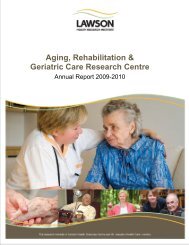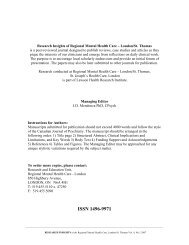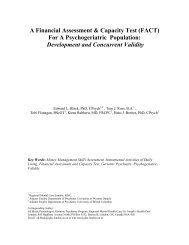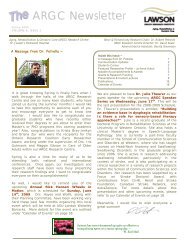REFORMS TO ONTARIO'S MENTAL HEALTH ACT: Lessons from ...
REFORMS TO ONTARIO'S MENTAL HEALTH ACT: Lessons from ...
REFORMS TO ONTARIO'S MENTAL HEALTH ACT: Lessons from ...
- No tags were found...
Create successful ePaper yourself
Turn your PDF publications into a flip-book with our unique Google optimized e-Paper software.
19of the public to perpetrate violent acts, 90 serious assaults and homicides involving strangers are rare 91 andhard to predict. 92While the reduction of serious violence is unlikely to be the primary benefit of C<strong>TO</strong>s for the reasonsoutlined above, there is evidence that C<strong>TO</strong>s do reduce violent behaviour. 93 Moreover, we argue thatArenburg’s history of threats and physical violence caused by delusions, coupled with the failure to treatthese delusions, made further violence entirely predictable. Arenburg’s subsequent clinical history showsthat when he received sustained treatment with antipsychotic medication, his symptoms fully remitted.Moreover, Arenburg’s psychotic symptoms only returned when he apparently stopped his medication.Therefore, it is difficult not to conclude that Smith’s life could have been saved, and Arenburg’s lifecould have been much less restricted, had he received appropriate psychiatric treatment earlier.So what treatment did Arenburg need? Patients with psychotic illnesses, such as schizophrenia, startshowing improvement in their hallucinations and delusions after several days of antipsychotic treatment. 94However, complete resolution of symptoms sometimes takes up to eight weeks of treatment, 95 and somepatients do not recover fully. The development of insight - awareness that the hallucinations anddelusions are a product of illness - may require many months of additional treatment and again for manypatients, full insight is never achieved. 96 A course of sustained treatment could have been administeredduring any one of Arenburg’s three hospital admissions before he killed Smith. This did not happen ontwo admissions because a physician discharged Arenburg despite his recent threats to harm others and the90 Although this conclusion is still occasionally challenged in the literature, most scholars have accepted that there is anassociation. Prominent researchers, such as Professor John Monahan, who at one point had argued against an association, issued aconsensus statement with mental health advocates acknowledging the association in 1994 (John Monahan & Jean Arnold,Violence by People with Mental Illness: A Consensus Statement by Advocates and Researchers, 19:4 Psychiatr, Rehabil. J. 67(1996)).Subsequent methodologically rigorous studies have confirmed the association. Overall, the association is modest and strongeramong females than among male offenders. It is also stronger in cases of homicides as opposed to less severe violence (PatriciaA. Brennan et al, Major Mental Disorders and Criminal Violence in a Danish Birth Cohort, 57:5 Arch. Gen. Psychiatry 494(2000)); Seena Fazel et al, Schizophrenia and Violence: Systematic Review and Meta-Analysis, 6(8):e 1000120. PLoS Med.(Epub August 11, 2009)).91 Olav Nielssen et al, Homicide of Strangers by People with a Psychotic Illness, 37:3 Schizophr. Bull. 572 (2011).92 Jeffrey Swanson, Explaining Rare Acts of Violence: The Limits of Evidence <strong>from</strong> Population Research 62:11 Psychiatr. Serv.1369 (2011).93 Bruce G. Link et al, Arrest Outcomes Associated with Outpatient Commitment in New York State, 62:5 Psychiatr. Serv. 504(2011).94 Drugs and Other Physical Treatments, in Michael Gelder, Paul Harrison, & Philip Cowen, eds, Shorter Oxford Textbook ofPsychiatry, 5 th ed (Oxford, UK: Oxford University Press, 2006) 539 at 517-576.95 Robin Emsley et al, Time Course for Antipsychotic Treatment Response in First-Episode Schizophrenia, 163:4 Am. J.Psychiatry 743 (2006).96 Faith B. Dickerson et al, Lack of Insight Among Outpatients with Schizophrenia, 48:2 Psychiatr. Serv. 195 (1997).RESEARCH INSIGHTS of the Regional Mental Health Care London and St. Thomas; Vol. 9, No.3, 2012














